
La Earthcache / The Earthcache
► Le site d'observation : L’église monolithe de Saint Emilion
L’église monolithe est un édifice religieux souterrain bâti au début du XIIème siècle au coeur de la cité de Saint Emilion.
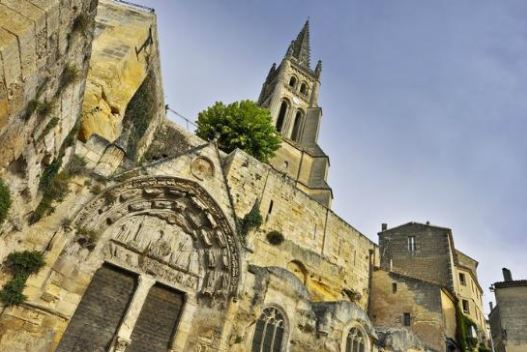
Elle présente la particularité d'être creusée à l’intérieur du plateau calcaire. Les parties extérieurs sont également constituées de cette roche prélevée in situ.
L'étude de la carte géologique nous permet de préciser la nature de cette roche.
La partie sommitale de Saint Emilion, ou est sise le cœur du village et son église, est constituée d'un ensemble calcaire Oligocène, le calcaire à Astéries et le calcaire de Castillon.
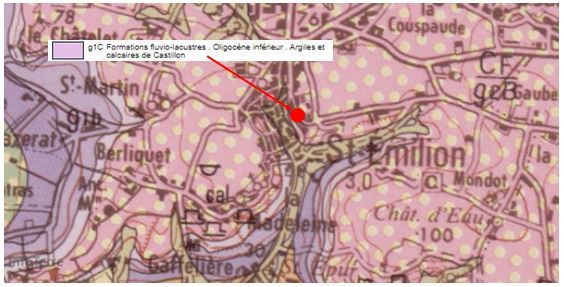
le banc communal de Saint Emilion est d'ailleurs un des hauts lieux d'extraction du calcaire à Astéries (Appelé « pierre de Bordeaux » ou « calcaire de Saint-Émilion »).
► Le calcaire à Astéries
Le calcaire à Astéries est une roche sédimentaire biogénique, c'est à dire issue de l'agglomération et la solidification de restes d'organismes vivants fossiles.
Son origine marine est attestée par la présence de fossiles : huîtres, coraux, osselets d'étoiles de mer.
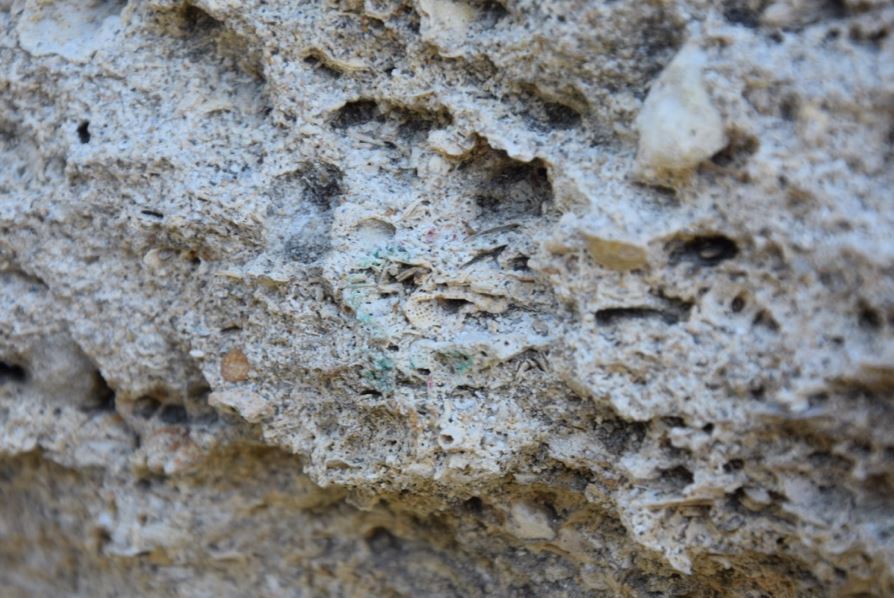
D'une puissance maximale de 25 mètres, cette formation s'est mise en place à l'Oligocène inférieur (étape du Stampien) dans un système aquifère situé de part et d'autre de la Garonne.

Ce calcaire bioclastique présente une belle couleur blonde ou crème, parfois jaunâtre, et est disposé en lits centimétriques présentant des stratifications entrecroisées.
Cette formation massive est une roche facile à travailler, mais ce qui en fait une qualité d'exploitation est également un faiblesse.
C'est en effet une roche tendre, friable et très poreuse (porosité moyenne proche de 40 %), ce qui la rend particulièrement sensibilité à l'altération atmosphérique.
Étudions ses formes d'altérations dont les caractéristiques résultent des propriétés physico-chimiques de la roche et de son environnement à l'air libre.
► Les facteurs d'altération d'une roche calcaire
Au contact de l'air atmosphérique et des éléments, de nombreux mécanismes de dégradation de la roche calcaire se mettent en place.
Les origines des altérations sont de plusieurs natures :
- L'eau est le principal agent de dégradation de la pierre. Son action peut être aggravée par l'effet de l'air. L'eau s'attaque à la pierre sous forme d'eau de pluie, de ruissellement, de vapeur d'eau, de remontée capillaire.
- Le gaz carbonique, dissous dans l'eau, présente également un rôle de dissolution chimique du carbonate de calcium composant le calcaire.
- Le développement de micro-organismes et de végétaux (lichens, algues, mousses, champignons), dont les sécrétions acides dissolvent également le CaCO3.
- Le sel, qui entraîne une forme particulière d'altération appelée haloclastie donnant à la roche des formes alvéolaires. Bien qu'éloigné de la côté, le territoire de Saint Emilion subit les vents d'ouest marins remontant depuis l'estuaire.
- Le gel/dégel qui peuvent faire éclater la pierre selon la porométrie du matériau (capacité des pores à stocker et rejeter l'eau).
► Les types d'altérations du calcaire à Astéries
Ils sont de sont de trois natures :
- la desquamation : la pierre se désagrège en plaques, la couche inférieure devenant sableuse.
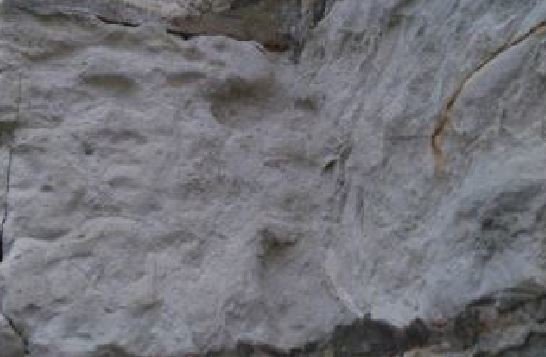
- la pulvérulence : la pierre se désagrège en poussière/grains de sable.
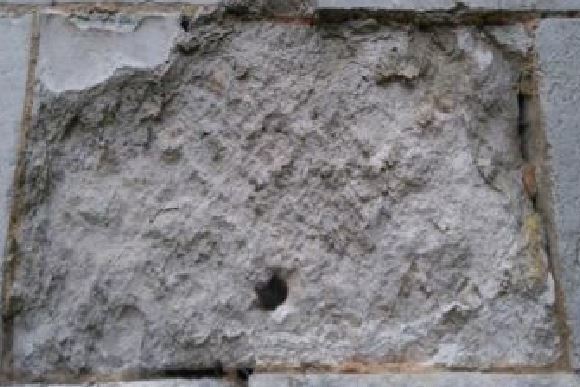
- l'alvéolisation / haloclastie : la pierre présente des cavités (profondément rongée telle un gruyère) ; cette forme d'altération est particulièrement lié au phénomène d'haloclastie expliquée ci-dessus.

► Le principe d'altération différentielle
L'effet de l'altération sur une roche calcaire dépend de sa nature et de ses caractéristiques physiques, principalement la porosité et la dureté des éléments qui composent ce calcaire.
Le calcaire à Astéries à Saint Emilion présente une grande variation de faciès, se traduisant par une variabilité des caractéristiques physiques et mécaniques du matériel.
Ces variation, parfois au sein d'un même bloc, vont avoir un impact direct sur la sensibilité de la roche à l'altération :
- La proportion de clastes de fossiles calcaires durs avec une forte densité de débris coquilliers va mettre en place une cuirasse résistante à l'érosion.
- A contrario, l’existence de lentilles de ciment calcaire friables et peu cohérentes va provoquer une altération accélérée.

► The site of observation: The monolithic church of Saint Emilion
The monolithic church is an underground religious building built in the early 12th century in the heart of the city of Saint Emilion.
It has the particularity of being dug inside the limestone plateau. The outer parts also consist of this rock taken in situ.
The study of the geological map allows us to specify the nature of this rock.
The upper part of Saint Emilion, where the heart of the village and its church is located, is made up of an Oligocene limestone complex, the limestone with Astéries and the limestone of Castillon.
the territory of Saint Emilion is besides one of the high places of extraction of the limestone with Astéries (Called "stone of Bordeaux" or "limestone of Saint-Emilion").
► The limestone at Astéries
Asteria limestone is a biogenic sedimentary rock, that is from the agglomeration and solidification of remains of living fossil organisms.
Its marine origin is attested by the presence of fossils: oysters, corals, ossicles of starfish.
With a maximum power of 25 meters, this formation was set up at the Lower Oligocene (Stampian stage) in an aquifer system located on both sides of the Garonne.
This bioclastic limestone has a beautiful blond or cream color, sometimes yellowish, and is arranged in the form of deposits arranged in centimetric beds with intersecting stratifications.
This massive formation is an easy rock to work on, but making it a working grade is also a weakness.
It is indeed a soft rock, friable and very porous (average porosity close to 40%), which makes it particularly sensitive to weathering.
Let us study its forms of alterations whose characteristics result from the physico-chemical properties of the rock and its environment in the open air.
► The alteration factors of a limestone rockn
In contact with the atmospheric air and the elements, many mechanisms of degradation of the limestone rock are put in place.
The origins of the alterations are of several kinds:
- Water is the main agent of degradation of the stone. Its action can be aggravated by the effect of air. The water attacks the stone in the form of rainwater, runoff, water vapor, capillary rise.
- Carbon dioxide, dissolved in water, also has a role of chemical dissolution of the calcium carbonate composing the limestone.
- The development of microorganisms and plants (lichens, algae, mosses, fungi), whose acidic secretions also dissolve CaCO3.
- Salt, which causes a particular form of alteration, called haloclasticity, and gives the rock alveolar forms. Although distant from the side, the territory of Saint Emilion undergoes the westerly winds rising from the estuary.
- The freeze / thaw that can break the stone according to the porometry of the material (ability of the pores to store and reject water).
► The types of limestone alterations at Astéries
They are of three natures:
- desquamation: the stone breaks up into slabs, the lower layer becoming sandy.
- powderiness: the stone breaks up into dust / grains of sand.
- the alveolization / haloclastic: the stone presents cavities (deeply eaten like a gruyère); this form of alteration is particularly related to the haloclastic phenomenon explained above.
► The principle of differential alteration
The effect of weathering on a limestone rock depends on its nature and physical characteristics, mainly the porosity and hardness of the elements that make up this limestone.
The limestone at Astéries in Saint Emilion presents a large variation of facies, resulting in a variability of the physical and mechanical characteristics of the material.
These variations in physico-mechanical characteristics, sometimes within the same block, will have a direct impact on the sensitivity to rock weathering: - The proportion of hard limestone fossil clasts with a high density of shelly debris will set up an erosion resistant breastplate.
- On the other hand, the existence of friable and inconsistent limestone cement lenses will cause accelerated weathering.
► Sources bibliographiques / Bibliographical sources
Les Questions / The Questions
La lecture attentive du descriptif de la cache, ainsi qu'une observation des éléments de terrain et un peu de déduction sont normalement suffisants pour répondre aux questions de cette EarthCache.
A careful reading of the description of the cache, as well as observation of terrain features and some deduction is usually sufficient to answer questions of this EarthCache.
Questions pour valider :"Altération à Saint Emilion"
Questions to validate: "Alteration in Saint Emilion"
Vous voici devant la partie aérienne de l’église monolithe de Saint Emilion, sur la facade exposée au Nord/Nord_Est.
C'est un lieu privilégié pour étudier les différentes formes d'altération du calcaire à Astéries (voir photo WP1).
Here you are in front of the aerial part of the monolithic church of Saint Emilion, on the facade exposed to the North / Nord_Est.
It is a privileged place to study the different forms of alteration of the Astéries limestone (see photo WP1).
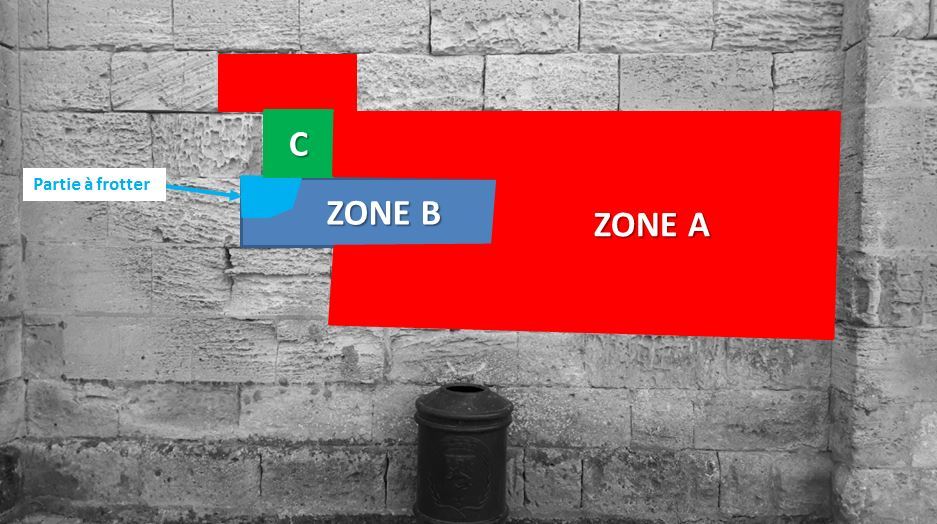
- Question 1 : Décrire la forme d'altération prédominante de la majorité des blocs des niveaux de rangées 4 à 7 au dessus du sol (zone rouge de la photo WP1) ? A quoi ces formes altérées vous font-elles penser ? Quel est le principal agent en cause dans ce mécanisme d'altération ?
- Question 1 : Describe the predominant form of weathering of most blocks in rows 3 levels above ground (red zone of photo WP1)? What do these altered forms make you think of? What is the main agent involved in this alteration mechanism?
- Question 2 : Frotter vos doigts sur la zone zone bleue claire du bloc B. Déduisez-en la forme de dégradation de cette partie. L’altération est-elle homogène au niveau de ce bloc bleue ? Justifier votre réponse.
- Question 2 : Rub your fingers over the light blue area of the B block. Deduce the damage form of this part. Is the alteration homogeneous at this blue block? Justify your answer.
- Question 3 : Evaluer le niveau d'altération du bloc vert C par rapport aux blocs voisins. Pourquoi son niveau d'altération est-il différent ?
- Question 3 : Evaluate the level of alteration of the green block C with respect to neighboring blocks. Why is its level of alteration different?
Vous pouvez vous loguer sans attendre notre confirmation,
mais vous devez nous envoyer les réponses en même temps soit par mail via notre profil (
fafahakkai), soit via la messagerie geocaching.com (Message Center).
S'il y a des problèmes avec vos réponses nous vous en ferons part.
Les logs enregistrés sans réponses seront supprimés.Une photo de vous ou de votre GPS avec l’église monolithe de Saint Emilion (hors WP) arrière plan est la bienvenue, mais n'est pas obligatoire.
You can log this cache without waiting for our confirmation, but you must send us the answers at the same time, by e-mail via our profile (fafahakkai) or by the system of Message Center of geocaching.com.
If there is a problem with your answers we will notify you. The logs recorded without answers will be deleted.
A photo of you or your GPS with the monolithic church of Saint Emilion (excluding WP) background is welcome, but not mandatory.
Rappel concernant les « Earthcaches »: Il n'y a pas de conteneur à rechercher ni de logbook à renseigner. Il suffit de se rendre sur les lieux, de répondre aux questions ci-dessus et de nous renvoyer les réponses.
Reminder concerning "Earthcaches": there is neither a container to look for nor a logbook to sign. One need only go to the location, answer to the differents questions and send us the answers.